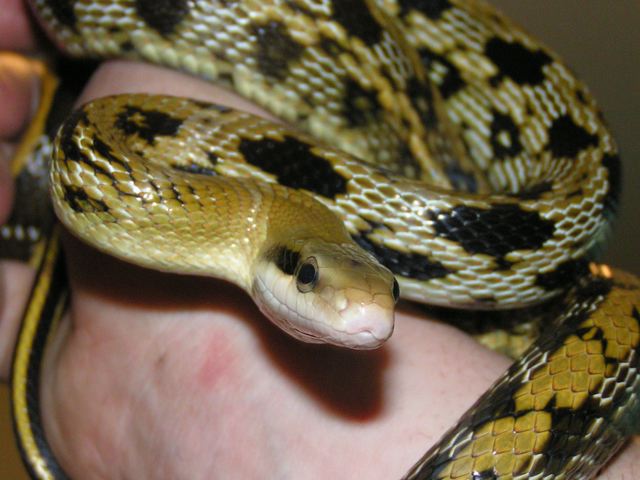Click: The Natural History and Captive Husbandry of the Taiwan Beauty Snake or Chinese Ratsnake, Orthriophis (formerly “Elaphe”) taeniurus friesei to read about the Natural History of the Taiwan Beauty Snake
Captive Husbandry
 Space and Physical Requirements
Space and Physical Requirements
Taiwan beauty snakes are quite active and require a larger cage than other similarly-sized snakes – they do not do well when cramped. A cage with sufficient height for climbing is a must – both for your pleasure in observing the animal, and for the snake’s well-being. A cage with the dimensions 3’(l) x 3’(w) x 5’(h) would be the minimum required by a 5 foot long individual.
The cage should be well perched with stout branches. Taiwan beauty snakes will also utilize vines, moving about them with a speed that leaves little doubt as to their abilities to capture squirrels, birds and other elusive prey. Hagen Bendable Vines interspersed among the branches will allow your pet to show off its natural behaviors to their best effect.
Taiwan beauty snake prefer an arboreal hideaway, and will readily take advantage of a forked branch hidden behind a screen of plants (Hagen Large Hanging Terrarium Plants are ideal). Particularly shy individuals will appreciate a piece of rolled cork bark wedged among the branches.
Light, Heat, Humidity
This species does not require a source of UVB light, but there is increasing evidence that UVA light is important in stimulating natural behavior and possibly in maintaining over-all good health. I suggest equipping your snake’s terrarium with a Coralife Reptile Bright Spotlight, which will supply both heat and UVA radiation.
A temperature of 80 F at the basking site will suffice – Taiwan beauty snakes do not seem to seek out the higher temperatures favored by some other tropical species. The ambient air temperature should fall 74 and 78 F.
Members of this genus favor slightly humid environments, but will suffer fungal and other skin disorders if not able to dry out as well. A light misting once or twice each day should suffice.
One Taiwan beauty snake that I kept invariably came to drink from the hose each morning when I misted her cage, but most will prefer a water bowl. The bowl should be large enough for soaking, as this species is prone to shedding difficulties if kept too dry. Be sure to spray the cage a bit more frequently at shedding time as well.
For arboreal snakes favoring humid environments, I use a substrate that holds moisture for awhile, but which dries out completely within a few hours after being misted. A mix of Keeper’s Choice Hardwood Bedding and Hagen Forest Bark Reptile Bedding works very well in this regard.
Feeding
Many arboreal snakes, such as the red-tailed ratsnake (Gonyosoma oxycephala), show a strong preference for feeding on birds, but I have not seen this with Taiwan beauty snakes. They do fine on a diet composed of mice and small rats.
Captive Longevity
Captives have lived in excess of 15 years.
Handling and Enrichment
Some individuals do adjust well to gentle handling, but in general this species is far better suited as an exhibit animal. Even well-habituated animals must be handled frequently, and starting from a young age, if they are to remain tractable. Taiwan beauty snakes do not take well to being grabbed and restrained, which complicate removal from the complex, branch-filled environments that suit them best.
Their high activity levels suit them well as subjects of observation, and in a large, naturalistic terrarium these snakes will provide you with fascinating glimpses into their lives. They appear much more alert than many species, and will investigate unusual movements around their cage. You can capitalize on this propensity by “scenting” their cage with novel odors – i.e. a snake or lizard shed, an egg – so that you can observe their reactions (in zoo circles, this is long-known practice is now termed “enrichment” and is currently very much in vogue).
Breeding
Taiwan beauty snakes may breed spontaneously, but consistent results have been obtained following a brumation (cooling-off) period of 3 months or so at 65-68 F. Most breeders chill their snakes between December and March, but this time period is likely not set in stone. Mating usually occurs within a month after the snakes are returned to optimal temperatures, with 6-10 eggs being deposited 40-60 days thereafter.
The eggs hatch in 55-62 days when incubated at 80-84 F and 95% humidity. The hatchlings average 12-16 inches long, and shed within their first 2 weeks. In contrast to many arboreal species, they do not prefer or need lizards or treefrogs, and will accept pink mice readily. Captives (this may vary in the wild) reach sexual maturity at approximately 18 months of age and 4.5 – 5 feet in length.
You can read more about the natural history and taxonomy of Asian ratsnakes at:
http://www.tigr.org/reptiles/species.php?genus=Orthriophis&species=taeniurus
 That Reptile Blog – Reptile, Amphibian and Exotic Pet Care and Information
That Reptile Blog – Reptile, Amphibian and Exotic Pet Care and Information
